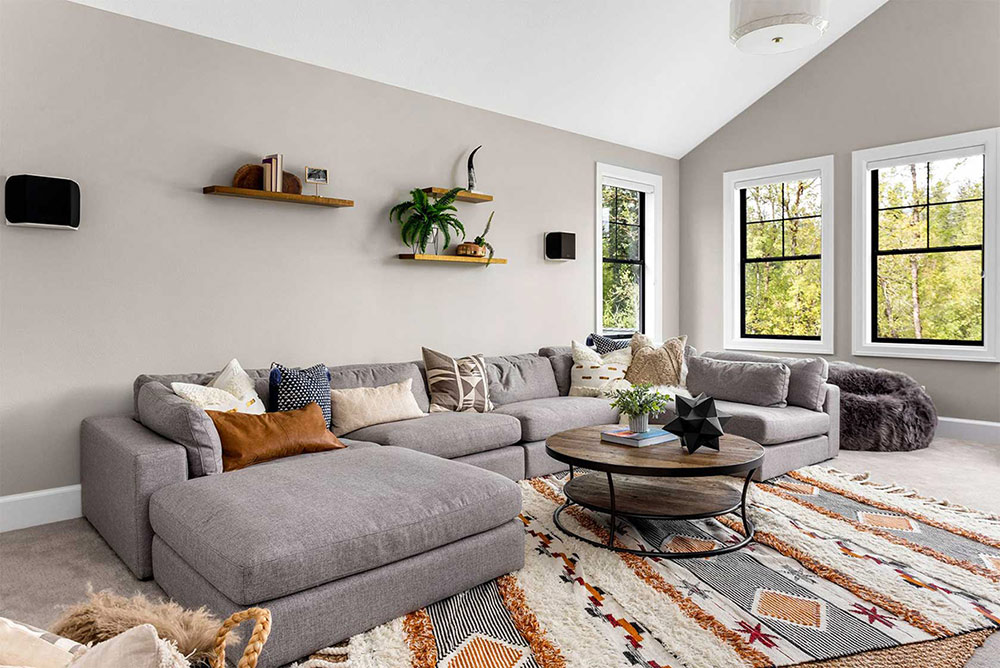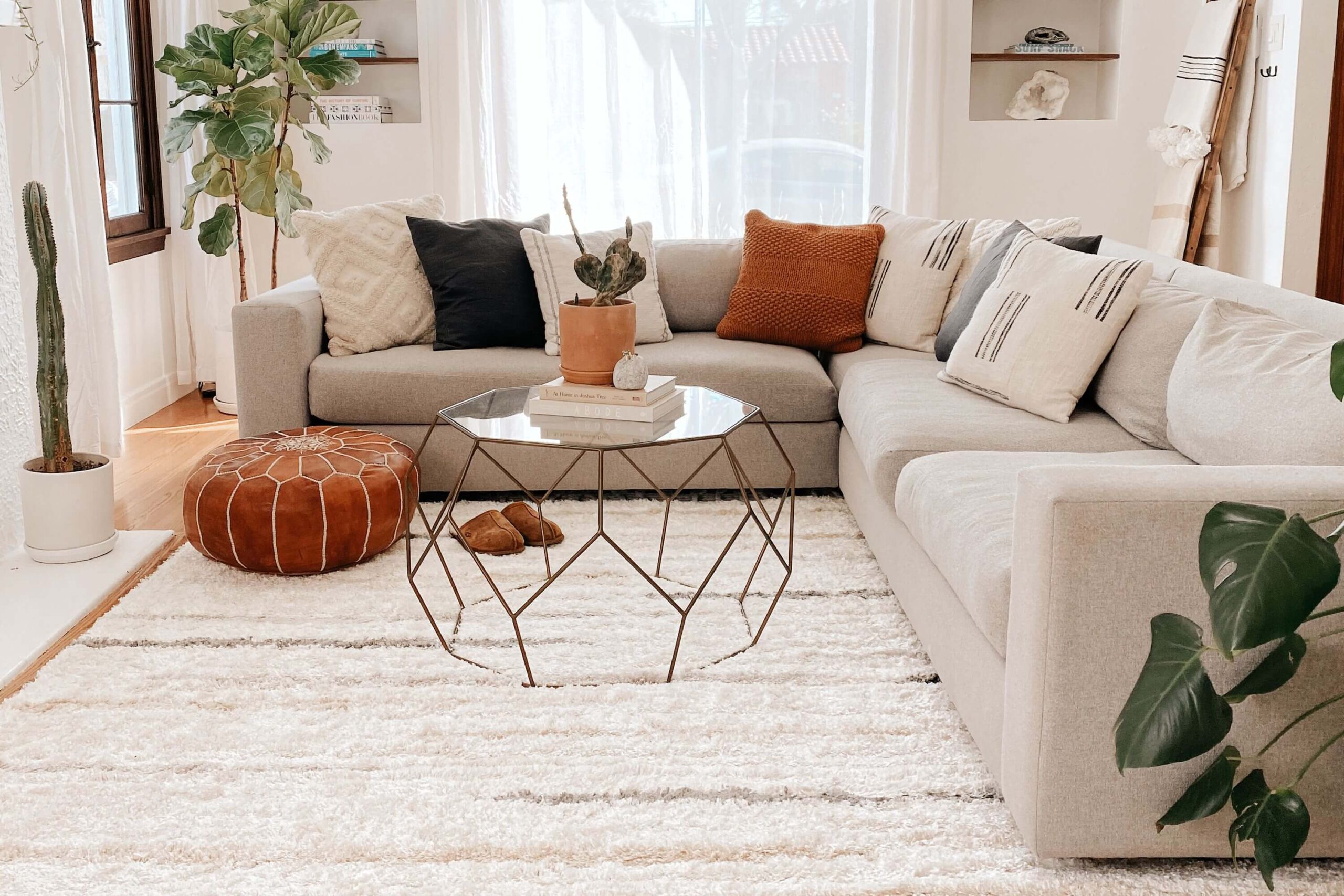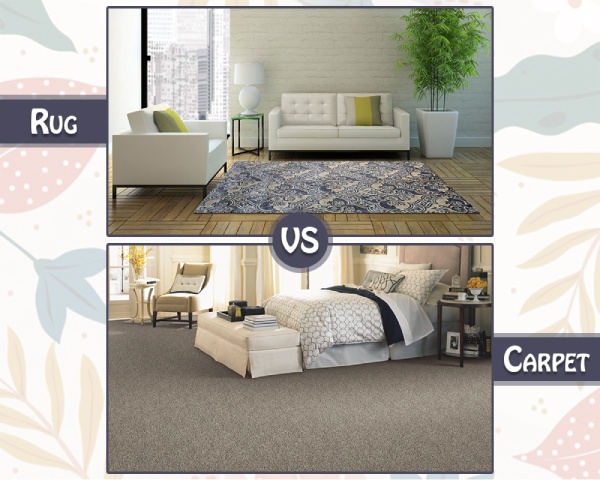Adding a rug to your living room may seem like a simple decision, but it can actually have a big impact on the overall look and feel of your space. But do you really need a rug in your living room? The answer is, it depends. Let's explore the pros and cons of having a rug in your living room and help you decide if it's the right choice for you. Rug in living room: Do you need it?
There are several benefits to having a rug in your living room. Firstly, it can add warmth and coziness to the space, making it more inviting and comfortable. Rugs also have the ability to tie the room together and add a pop of color or pattern. They can also act as a buffer between your feet and the hard floor, making it more comfortable to walk or sit on. Additionally, rugs can help to reduce noise and provide insulation, especially if you have hardwood or tile floors in your living room. The benefits of having a rug in your living room
When it comes to choosing a rug for your living room, there are a few things to consider. The first is the size of your space. A rug that is too small can make the room feel disjointed, while a rug that is too large can overwhelm the space. It's important to measure your living room and choose a rug that will fit comfortably in the area. Next, think about the style and design of your living room. You want your rug to complement the existing decor and not clash with it. Consider the colors and patterns in your living room and choose a rug that will enhance them. It's also important to consider the material of the rug. Natural fibers like wool and cotton are durable and easy to clean, while synthetic materials like polyester and nylon are more budget-friendly. However, they may not hold up as well in high traffic areas. How to choose the perfect rug for your living room
The placement of your rug can also have a big impact on the overall look and feel of your living room. A popular placement option is to have the front legs of your furniture on the rug, with the back legs off. This creates a cohesive and pulled together look. Alternatively, you can have all of your furniture completely on the rug, which can make the space feel more intimate. Just make sure the rug is large enough to accommodate all of your furniture. Rug placement in a living room
There are a few dos and don'ts to keep in mind when using a rug in your living room. Do choose a rug that is the right size for your space. Do consider the style and design of your living room when choosing a rug. Do place furniture on the rug for a more cohesive look. Don't choose a rug that is too small for your space. Don't choose a rug that clashes with the existing decor. Don't place all of your furniture off the rug, as this can make the space feel disconnected. The dos and don'ts of using a rug in your living room
One common question when it comes to living room flooring is whether to use a rug or carpet. While both options have their pros and cons, it ultimately comes down to personal preference and the needs of your space. Rugs offer more flexibility as they can be easily moved or changed out, while carpet is a more permanent option. Additionally, rugs can add a pop of color or pattern, while carpet is typically a neutral color. Consider your lifestyle and the look you want to achieve in your living room before deciding between a rug or carpet. Rug vs. carpet in a living room
Proper cleaning and maintenance is important to ensure your rug stays in good condition. Regularly vacuuming your rug can help to remove dirt and debris that can cause wear and tear. If you have a spill or stain, it's important to act quickly and blot the area with a clean cloth to prevent it from setting. For tougher stains, you may need to use a specialized rug cleaner. It's also a good idea to rotate your rug every few months to prevent uneven wear and fading. If your rug gets a lot of foot traffic, consider investing in a rug pad to provide extra cushioning and prevent slipping. How to clean and maintain a rug in your living room
As mentioned earlier, the material of your rug is an important factor to consider when choosing the perfect rug for your living room. Some popular options for living room rugs include wool, cotton, jute, and synthetic materials like polyester and nylon. Wool is a durable and luxurious option, but it can be more expensive. Cotton is soft and easy to clean, but it may not hold up as well in high traffic areas. Jute is a natural and affordable option, but it may not be as soft or comfortable to walk on. Synthetic materials are budget-friendly and easy to clean, but they may not be as durable as natural fibers. The best rug materials for a living room
Choosing the right size rug for your living room is essential for creating a balanced and cohesive look. A general rule of thumb is to leave 18-24 inches of space between the edge of the rug and the walls. This will help to create a border around the rug and make the room feel more spacious. If you have a larger living room, you may want to consider layering rugs to add more dimension and texture to the space. Rug size guide for a living room
Still not sure if a rug is necessary for your living room? Take a look at some before and after photos of living rooms with and without rugs. The difference can be striking and may help you make your decision. Remember, a rug can truly transform the look and feel of your living room, so don't be afraid to experiment with different styles and designs until you find the perfect fit for your space. Adding a rug to your living room: Before and after
Benefits of Adding a Rug to Your Living Room

Enhances Aesthetics
 Adding a rug to your living room can instantly elevate the overall look and feel of the space. It adds a layer of texture and color that can tie the room together and create a cohesive design. A
well-chosen rug
can serve as a focal point in the room, drawing the eye and adding visual interest. With the right rug, you can
complement
the existing decor and
enhance
the overall aesthetics of your living room.
Adding a rug to your living room can instantly elevate the overall look and feel of the space. It adds a layer of texture and color that can tie the room together and create a cohesive design. A
well-chosen rug
can serve as a focal point in the room, drawing the eye and adding visual interest. With the right rug, you can
complement
the existing decor and
enhance
the overall aesthetics of your living room.
Comfort and Warmth
 One of the main reasons to consider adding a rug to your living room is for the
comfort and warmth
it provides. In colder months, a rug can act as an insulator, keeping your feet warm and cozy. It also provides a soft and comfortable surface for lounging and relaxing. With the right rug, you can create a
welcoming and inviting
atmosphere in your living room that will make you and your guests feel right at home.
One of the main reasons to consider adding a rug to your living room is for the
comfort and warmth
it provides. In colder months, a rug can act as an insulator, keeping your feet warm and cozy. It also provides a soft and comfortable surface for lounging and relaxing. With the right rug, you can create a
welcoming and inviting
atmosphere in your living room that will make you and your guests feel right at home.
Noise Reduction
 If you have hardwood or tile flooring in your living room, you may have noticed that it can be quite noisy with footsteps and other sounds echoing throughout the space. Adding a rug can help
absorb
some of that noise, making your living room a quieter and more peaceful place. This is especially beneficial for those who live in apartments or have multiple levels in their home.
If you have hardwood or tile flooring in your living room, you may have noticed that it can be quite noisy with footsteps and other sounds echoing throughout the space. Adding a rug can help
absorb
some of that noise, making your living room a quieter and more peaceful place. This is especially beneficial for those who live in apartments or have multiple levels in their home.
Defines and Zones the Space
 A rug can also serve as a tool for
defining and zoning
different areas within your living room. For example, if you have an open concept living room that flows into the dining area, a rug can help differentiate the two spaces and create a sense of separation. You can also use a rug to
anchor
your furniture and create a designated sitting area, making the room feel more organized and put together.
A rug can also serve as a tool for
defining and zoning
different areas within your living room. For example, if you have an open concept living room that flows into the dining area, a rug can help differentiate the two spaces and create a sense of separation. You can also use a rug to
anchor
your furniture and create a designated sitting area, making the room feel more organized and put together.
Easy to Update and Change
 One of the best things about adding a rug to your living room is that it is an
easy and cost-effective
way to update and change the look of the room. If you get tired of the design or want to switch things up, you can simply swap out the rug for a new one. This allows you to experiment with different colors, patterns, and textures without having to make major changes to your decor.
In conclusion, a rug is a
versatile and essential
addition to any living room. It not only enhances the aesthetics of the space but also provides comfort, reduces noise, defines the space, and allows for easy updates. So, if you want to create a cozy and stylish living room, consider adding a rug today.
One of the best things about adding a rug to your living room is that it is an
easy and cost-effective
way to update and change the look of the room. If you get tired of the design or want to switch things up, you can simply swap out the rug for a new one. This allows you to experiment with different colors, patterns, and textures without having to make major changes to your decor.
In conclusion, a rug is a
versatile and essential
addition to any living room. It not only enhances the aesthetics of the space but also provides comfort, reduces noise, defines the space, and allows for easy updates. So, if you want to create a cozy and stylish living room, consider adding a rug today.
Benefits of Adding a Rug to Your Living Room

Enhances Aesthetics

Adding a rug to your living room can instantly elevate the overall look and feel of the space. It adds a layer of texture and color that can tie the room together and create a cohesive design. A well-chosen rug can serve as a focal point in the room, drawing the eye and adding visual interest. With the right rug, you can complement the existing decor and enhance the overall aesthetics of your living room.
Comfort and Warmth

One of the main reasons to consider adding a rug to your living room is for the comfort and warmth it provides. In colder months, a rug can act as an insulator, keeping your feet warm and cozy. It also provides a soft and comfortable surface for lounging and relaxing. With the right rug, you can create a welcoming and inviting atmosphere in your living room that will make you and your guests feel right at home.
Noise Reduction

If you have hardwood or tile flooring in your living room, you may have noticed that it can be quite noisy with footsteps and other sounds echoing throughout the space. Adding a rug can help absorb some of that noise, making your living room a quieter and more peaceful place. This is especially beneficial for those who live in apartments or have multiple levels in their home.
Defines and Zones the Space

A rug can also serve as a tool for defining and zoning different areas within your living room. For example, if you have an open concept living room that flows



















:max_bytes(150000):strip_icc()/living-room-area-rugs-1977221-e10e92b074244eb38400fecb3a77516c.png)
/Retouched-Laura-Genevieve-horizontal-af3b84469eb848d99572faeda9950803.jpg)











/AmyCooper-MarcellaAlanAfter1-5bef478326874b728b526bac19649802.jpg)













































:max_bytes(150000):strip_icc()/GettyImages-1210163723-8e0e5379056f4e79a75fb55b6f40aa3d.jpg)















